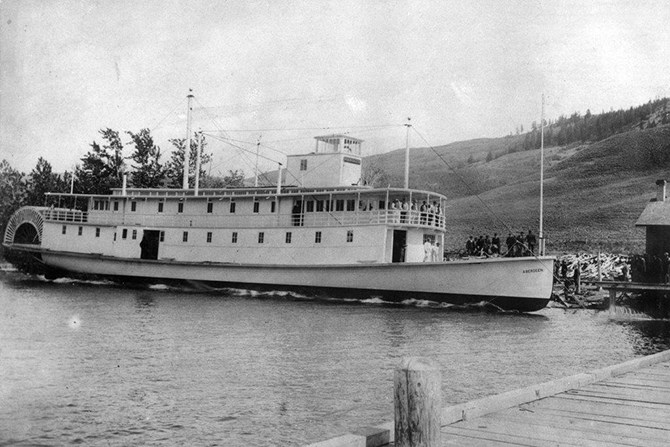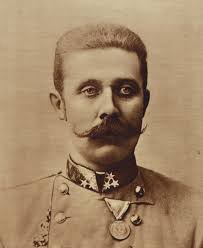
SS Aberdeen being launched in 1893 at Okanagan Landing near Vernon.
Archduke Ferdinand commandeered an almost empty vessel in September, 1893 when he made his way down Okanagan Lake on a hunting expedition west of Penticton.
Image Credit: Penticton Musum and Archives
March 30, 2017 - 6:30 PM
PART ONE OF A FOUR PART SERIES
PENTICTON WAS LITTLE MORE THAN TOM ELLIS'S RANCH WHEN FERDINAND ARRIVED IN 1893 TO HUNT GRIZZLY BEAR
Franz Ferdinand — the Austrian Archduke from your history books, not the Scottish rock band — is a name forever linked to the origin of World War I with his assassination in Sarajevo on June 18, 1914.
Heir to the Austro-Hungarian empire, he was one of the wealthiest men in Austria, when in 1889 he became first in line to the throne after his cousin, Crown Prince Rudolf committed suicide.
The burden of leadership didn’t stop the Archduke from an extensive round the world tour in 1893, which also took him across British Columbia on the Canadian Pacific Railway.
Ferdinand's daily journal is a chronicle of his entire odyssey around the world, giving the reader an interesting perspective on the author, and the times he travelled in.
An avid hunter, Ferdinand detoured briefly through the Okanagan Valley as his entourage organized a hunt for him out of Penticton in September, 1893.
His notes and observations of the trip were first published as two volumes in 1896, but weren't translated into English until 2014, when Jean-Claude Brunner, a translator based in Vienna, Austria, began the task.
Maurice Williams, a history professor emeritus from UBCO, is studying the English translations of Ferdinand’s accounts through Vancouver and the Okanagan. He is in the early stages of gathering material and sorting out places Ferdinand visited, as some of the names of landmarks in Ferdinand’s journals are no longer in use.

The Archduke Franz Ferdinand
Image Credit: Wikimedia commons
Williams plans to put together a lunch bag discussion on the topic this fall as part of the Penticton Museum’s popular series of historical talks.
“The story of Ferdinand’s life is about death. He is known to have killed 280,000 animals in his lifetime, and his assassination in Sarajevo is the most enduring fact of his life,” Williams says.
What makes Ferdinand’s visit unique is he was likely one of the first European tourists to the valley. He didn't come to settle or to work and he was wealthy and educated. His writings chronicle the thoughts and actions of an aristocrat making observations as a man with no vested interest in the region.
Ferdinand's seven-day tour of the Okanagan began on Sept. 10, 1893, by CPR from Banff.
He and his entourage arrived at Sicamous Junction where he says, “we were to use a line of the Canadian Pacific Railway going south.”
On Sept. 11, 1893, the Ferdinand party caught the newly opened railway line that was to take them to Vernon, where they would catch the steamer “Aberdeen” for a six-hour journey down Lake Okanagan to Penticton.
Ferdinand’s diary notes talk about the landscape of the Okanagan, which “had taken on a different character,” as they were "no longer looking at mountains and glaciers, but now into rolling low mountain ranges, long, densely wooded ridges above valleys in which wood lots alternated with cultivated fields and numerous farms indicated a level of prosperity,” he wrote.
Ferdinand noted “lakes full of game, including geese, ducks and grebes in a ‘delightful’ landscape.”
The party boarded the Aberdeen at Priests’ Landing. Ferdinand described Okanagan Lake as “extending like a river 121 kilometres south.”
The steamer cruised at 12 knots when burning wood, and Ferdinand described the lake as “smooth as glass, the day gorgeous.”
Arriving in Penticton, Ferdinand made an observation in his diary about future commerce and transportation routes expected to make their way into the tiny collection of residences at the south end of Okanagan Lake.
“There soon would be constructed a railway connection to the North Pacific railway of the United States, but in the meantime there is only demarked the space of the future station and a wooden hotel is under construction. With respect to the projected railway construction and the predicted rapid growth of the future town of Penticton the Canadian Pacific railway company already offers now a daily connection by steamboat, albeit at a loss only in order to uphold the first mover right of shipping on Lake Okanagan and pre-empt any potential competitors. At the moment, only rarely does a passenger use the line, most often a hunter or squatter,” Ferdinand wrote.
He also noted there were only two other passengers beyond his own entourage on the Aberdeen and thought the rail pursuit odd: “The American entrepreneurial spirit does not shy away from spending important sums if profits can be expected in the future.”
Penticton historian Randy Manuel says Ferdinand was witnessing the construction of the Hotel Penticton, a 20-bed hotel that opened for business in 1893 on Vancouver Hill at Van Horne Street.
It burned to the ground Oct. 7, 1927.
Manuel also notes promoters and land developers looking to make a quick buck had maps prepared as far back as the early 1890s showing four railways making inroads into the Penticton and Okanagan Falls area, including rails from the U.S.
Promoters boasted there would soon be a hospital, college, sawmills, a creamery and more in the “city.”
Ferdinand and his entourage worked late into the evening as they prepared for their hunting trip, heading up Shatford Creek the following day.
Next: The Archduke finds himself somewhat at odds with Penticton’s pioneer resident, Tom Ellis, and observes the local Indigenous population from his wealthy European perspective
To contact a reporter for this story, email Steve Arstad or call 250-488-3065 or email the editor. You can also submit photos, videos or news tips to the newsroom and be entered to win a monthly prize draw.
We welcome your comments and opinions on our stories but play nice. We won't censor or delete comments unless they contain off-topic statements or links, unnecessary vulgarity, false facts, spam or obviously fake profiles. If you have any concerns about what you see in comments, email the editor in the link above.
News from © iNFOnews, 2017